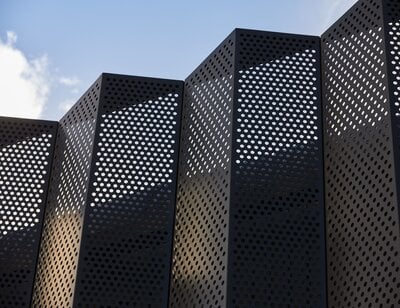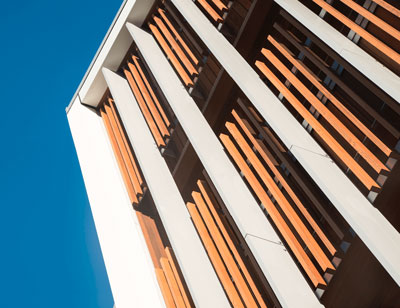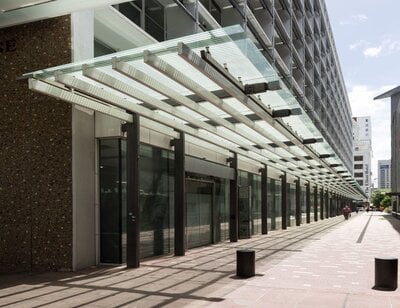The Burj Khalifa in Dubai cost a reported US$1.5 billion to build and takes a crew of 36 window cleaners around 3 months to clean the exterior. By which point it’s time to start again, stopping only to scowl at anyone who said ‘you missed a spot’.
Given both the size of the investment and the task to keep it sparkling, it would be understandingly irritating to see a flock of freeloading pigeons move in and proceed to cover the facade with their droppings, which are acidic enough to corrode and erode metals, stonework and brickwork. Those droppings are also a nuisance to clean as they can contain nasties like Cryptococcus, a yeast-like fungus that can be particularly harmful to anyone with a compromised immune system.
So how do owners of those wonderfully tall and beautiful buildings in the Gulf States keep their facades clean? They turn to the animal kingdom.
Falco cherrug
The Falcon is the pinnacle of natural design. A carnivorous killing machine with a wing span up to 1 metre, these raptors can reach dive speeds up to 320kmh, leaving prey with very little chance of escaping their talons. That prey? Well, they quite like pigeons.
The falcon has a unique place in society in the Middle East. Thousands of years ago nomadic tribes, such as the Bedouin, would trap migrating Saker Falcons, holding them captive and training them to catch food during times of the year when it was otherwise scarce (which would seem to be much of the year). The practice of falconry was soon flying (lazy pun intended) and spread along the Silk Road, changing over the years to move from sustenance hunting to a pastime for Royals and noblemen. Eventually, it became known as the ‘sport of kings’, and has occupied a rarified place in society ever since. Considered one of UNESCO’s Intangible Cultural Heritages of Humanity, it’s one of the oldest pastimes known to humankind and continues to attract crowds at events like the annual King Abdulaziz Falconry festival in Riyadh, Saudi Arabia.
Today, the falcon is a status symbol. Falcons have their own passports (they fly first-class or business class) as part of the fight against smuggling, and individual birds can fetch up to $500,000. There are falcon beauty contests, they live in air-conditioned aviaries, and their owners can even purchase a special Bentayga Falconry (made by Bentley), featuring a perch between the two front seats. Unless you’re a working falcon, anyway. Because then there’s a job to be done.
A Falcon Amongst The Pigeons
Pigeons can poop between 40-50 times a day and depending on the size of the pigeon, they can poop pretty close to their body weight every month. Whichever way you look at it, that’s a lot of poop from a single pigeon, and a lot of mess. Especially as pigeon flocks range in size from around 50, all the way up to 500.
The problem this poop poses for facades is significant. Aesthetically, it’s a pain and it needs cleaning. But the real damage is done from the uric acid present in the poop. It can corrode and erode metals and stonework. When it comes to aluminum facades, it’ll break down the protective aluminum oxide layer, expediting a chemical reaction which’ll eventually lead to pitting corrosion.
For the pigeons of Dubai and similar locations, it’s easy to see why all the tall buildings appeal. There’s plenty of places to nest away from the threat of mankind, it’s nice and peaceful, and the views are amazing. Unless they include the site of a falcon, anyway.
Building owners, rightly annoyed with their new facades being defecated on, are employing specialist falconry pest control businesses for prices starting at around $10,000 per month. For this, a falconer will fly his raptors around the building on a schedule that’s regular enough for pigeons to learn to stay away. So it’s not as if as soon as the falcons disappear, the pigeons reappear. They know better than to risk it. It’s a tricky job for the falconer though as their birds need to remain in plain sight or risk getting lost, which is why most are fitted with tracking collars.
In the UAE, it’s not just the pigeon causing issues but also the Indian crow. They migrated from Asia and have slowly pushed the other birds out. Yet even these crows know to keep their distance from a falcon.
Yet not everyone is happy with falcons used in such a way. They point to the history of falconry and believe it diminishes the bird when other methods for pest control are available, such as pills and ultrasound.
For building owners, it sure is effective though. So much so, the use of falcons in pest control isn’t limited to the Middle East. They’ve been used at the Piazza San Marco in Venice and Trafalgar Square in London. Although we imagine the belligerent cockney pigeons came back pretty quickly, rhyming slang insults on the tip of their beaks.
Other locations to have used falcons include the Houses of Parliament in London. As have Wimbledon organisers in an effort to keep centre court pigeon free. They’ve even been used at JFK in New York to chase away other birds and free up the airspace, reducing the risk of birdstrike.
What’s for certain is protecting your facade with falcons works. And let’s be honest, falcons really are beautiful creatures and seeing them fly is a sight to behold. We’re not sure any robotic solution will ever be as mesmerising to watch.








